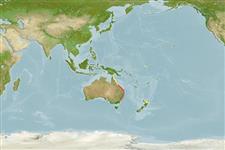>
Tetraodontiformes (Puffers and filefishes) >
Monacanthidae (Filefishes)
Etymology: Cantheschenia: Greek, kanthos = the outer or inner corner of the eye, where the lids meet, 1646 + Greek, schein, eko = to carry (Ref. 45335); grandisquamis: Name from the Latin word 'grandisquamis' (meaning large-scale), for the relatively large prominently outlined scales on the mid-side of the body.
Environment: milieu / climate zone / intervalo de profundidade / distribution range
Ecologia
marinhas associadas(os) a recifes; intervalo de profundidade ? - 29 m (Ref. 58018). Temperate
Western Pacific: Capricorn Group to New South Wales, Australia.
Tamanho / Peso / Idade
Maturidade: Lm ? range ? - ? cm
Max length : 26.0 cm TL macho/indeterminado; (Ref. 2334)
Descrição breve
Chaves de identificação | Morfologia | Morfometria
Raios dorsais moles (total) : 39; Raios anais moles: 36; Vértebras: 19. Diagnosis: Relatively large scales on side of body with prominent outlines forming a reticulate pattern, each scale with many small spinules arranged in series radiating from a slightly larger central spinule. Soft dorsal rays 39, anal rays 36, pectoral rays 13. Color pattern consists of a dark brown to yellowish brown background with a patch of iridescent blue spots on side of throat and breast; a similarly colored line along basal sheath of both soft dorsal and anal fins, and upper and lower 4 rays of caudal fin dark blue, with a black bar along posterior margin, the remainder of fin yellow-orange (Ref. 35708).
Body shape (shape guide): short and / or deep; Cross section: compressed.
In sheltered coastal and offshore reefs. Uncommon (Ref. 9710).
Life cycle and mating behavior
Maturidade | Reprodução | Desova | Ovos | Fecundidade | Larvas
Randall, J.E., G.R. Allen and R.C. Steene, 1990. Fishes of the Great Barrier Reef and Coral Sea. University of Hawaii Press, Honolulu, Hawaii. 506 p. (Ref. 2334)
Categoria na Lista Vermelha da IUCN (Ref. 130435: Version 2025-1)
Ameaça para o homem
Harmless
Utilização humana
Ferramentas
Relatórios especiais
Descarregue XML
Fontes da internet
Estimates based on models
Preferred temperature (Ref.
123201): 21.4 - 26.7, mean 25.2 °C (based on 181 cells).
Phylogenetic diversity index (Ref.
82804): PD
50 = 0.7500 [Uniqueness, from 0.5 = low to 2.0 = high].
Bayesian length-weight: a=0.01995 (0.00956 - 0.04164), b=2.93 (2.76 - 3.10), in cm total length, based on LWR estimates for this (Sub)family-body shape (Ref.
93245).
Nível Trófico (Ref.
69278): 2.9 ±0.4 se; based on size and trophs of closest relatives
Resiliência (Ref.
120179): Médio, tempo mínimo de duplicação da população 1,4 - 4,4 anos (Preliminary K or Fecundity.).
Fishing Vulnerability (Ref.
59153): Low vulnerability (16 of 100).
🛈
Nutrients (Ref.
124155): Calcium = 16.4 [6.1, 44.0] mg/100g; Iron = 0.236 [0.106, 0.577] mg/100g; Protein = 18.3 [16.0, 20.5] %; Omega3 = 0.256 [0.105, 0.555] g/100g; Selenium = 6.65 [2.66, 17.94] μg/100g; VitaminA = 39.9 [8.5, 197.8] μg/100g; Zinc = 0.645 [0.383, 1.122] mg/100g (wet weight);
